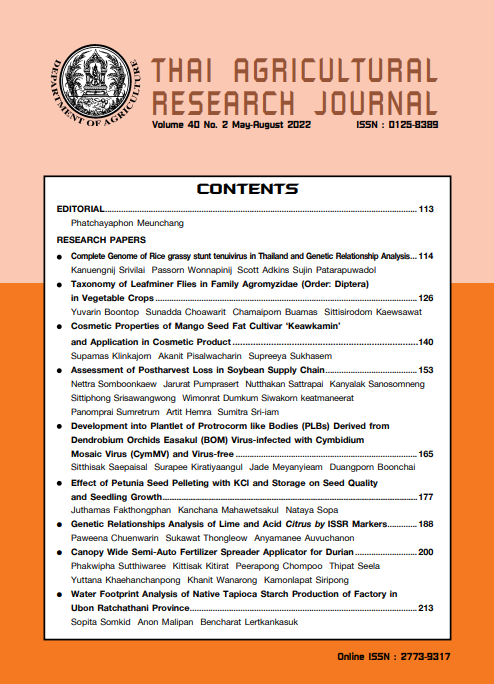Genetic Relationships Analysis of Lime and Acid Citrus by ISSR Markers
DOI:
https://doi.org/10.14456/thaidoa-agres.2022.16Keywords:
Mexican lime, Citrus, DNA markersAbstract
The major commercial lime cultivars in Thailand are Mexican lime (Citrus aurantifolia (Christm.) Swingle) and Tahiti lime (C. latifolia (Yu. Tanaka) Tanaka). Nevertheless, those cultivars are not resistant to diseases or the fruit qualities are not meet the demand. To improve new cultivars, lime and acid Citrus germplasms are the sources of parental lines. Together, the study of the genetic relationship between lime and acid Citrus germplasms will benefit the parental lines selection. This study aims to study the genetic relationships of 55 accessions of lime and acid Citrus germplasms with Inter Simple Sequence Repeat (ISSR) markers. Four primers of ISSR generated 33 DNA bands with 87.5% polymorphism. Dendrogram revealed the ability of 4 ISSR primers to cluster lime and acid Citrus into four groups, a group of Mexican lime and Tahiti lime, a group of citron and lemon, a group of kaffir lime, and a group of finger lime which were able to classified lime and acid Citrus according to their species. Focusing on 26 accessions of Mexican lime, ISSR primer 814 could distinguish Mexican lime into two groups. Group A contained 13 accessions in which the average fruit weight, fruit rind thickness, and seed number were all less than group B which also contained 13 accessions.
References
วสรรญ ผ่องสมบูรณ์. 2558. การปรับปรุงพันธุ์และเทคโนโลยีการผลิตมะนาว. รายงานโครงการวิจัย. กรมวิชาการเกษตร. พิจิตร. 96 หน้า.
สำนักงานมาตรฐานสินค้าเกษตรและอาหารแห่งชาติ. 2560. ประกาศกระทรวงเกษตรและสหกรณ์ เรื่อง กำหนดมาตรฐานสินค้าเกษตร: มะนาว. ตามพระราชบัญญัติมาตรฐานสินค้าเกษตร พ.ศ. 2551, กรุงเทพฯ. 9 หน้า.
Amar, M.H., M.K. Biswas, Z. Zhang and W.W. Guo. 2011. Exploitation of SSR, SRAP and CAPS-SNP markers for genetic diversity of Citrus germplasm collection. Sci. Hortic. 128(3): 220-227.
Biswas, M.K., Q. Xu and X.X. Deng. 2010. Utility of RAPD, ISSR, IRAP, and REMAP markers for the genetic analysis of Citrus spp. Sci. Hortic. 124(2): 254-261.
Carvalho, R., W.S. Soares Filho, A.C. Brasileiro-Vidal and M. Guerra. 2005. The relationships among lemons, limes and citron: a chromosomal comparison. Cytogenet. Genome Res. 109(1-3): 276-282.
Cheong, M.W., Z.S. Chong, S.Q. Liu, W.B. Zhou, P. Curran and B. Yu. 2012. Characterisation of calamansi (Citrus microcarpa). Part I: volatiles, aromatic profiles and phenolic acids in the peel. Food Chem. 134(2): 686-695.
Chuenwarin, P., S. Wiphuwathinee, R. Bowonchaikittikun, R. Chuenjit, W. Srinual, S. Napa, W. Imsabai and A. Auvuchanon. 2021. Genetic and morphological diversity analysis of lime and acidic Citrus spp. from two germplasm collections in Thailand. Agri. Nat. Resour. 55(4): 589-600.
Curk, F., F. Ollitrault, A. Garcia-Lor, F. Luro, L. Navarro and P. Ollitrault. 2016. Phylogenetic origin of limes and lemons revealed by cytoplasmic and nuclear markers. Ann. Bot. 117(4): 565-583.
Doyle, J.J. and J.L. Doyle. 1987. A rapid DNA isolation procedure for small quantities of fresh leaf tissue. Phytochem. Bull. 19(1): 11-15.
Dutt, M., D. Stanton and J.W. Grosser. 2016. Ornacitrus: Development of genetically modified anthocyanin-expressing citrus with both ornamental and fresh fruit potential. J. Am. Society Hort. Sci.. 141(1): 54-61.
Johnson, J.B., R. Batley, D. Manson, S. White and M. Naiker. 2022. Volatile compounds, phenolic acid profiles and phytochemical content of five Australian finger lime (Citrus australasica) cultivars. LWT-Food Sci. and Technol. 154: 112640.
Lu, Z.H., Z.Q. Zhou and R.J. Xie. 2011. Molecular phylogeny of the True Citrus Fruit Trees group (Aurantioideae, Rutaceae) as inferred from chloroplast DNA sequence. Agricultural Sciences in China. 10(1): 49-57.
Nicolosi, E., Z.N. Deng, A. Gentile, S. La Malfa, G. Continella and E. Tribulato. 2000. Citrus phylogeny and genetic origin of important species as investigated by molecular markers. Theor. Appl. Genet. 100: 1155-1166.
Wu, G.A., J. Terol, V. Ibanez, A. López-García, E. Pérez-Román, C. Borredá, C. Domingo, F.R. Tadeo, J. Carbonell-Caballero, R. Alonso, F. Curk, D. Du, P. Ollitrault, M.L. Roose, J. Dopazo, F.G. Gmitter Jr, D.S. Rokhsar and M. Talon. 2018. Genomics of the origin and evolution of Citrus. Nature. 554(7692): 311-316.
Downloads
Published
How to Cite
Issue
Section
License
Copyright (c) 2022 Thai Agricultural Research Journal

This work is licensed under a Creative Commons Attribution-NonCommercial-NoDerivatives 4.0 International License.
Thai Agricultural Research Journal



